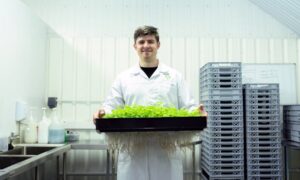Have you ever stopped to think about the incredible journey that your food takes from the farm to your table? Join us as we explore the fascinating process of how agricultural products make their way from seed to plate. Get ready to delve into the world of farming, harvesting, processing, and distribution, and gain a whole new appreciation for the delicious food on your dinner plate. Let’s uncover all the hard work, dedication, and innovation that goes into bringing fresh produce and other agricultural products straight to you!
Introduction to the Journey of Agricultural Products
Agriculture is one of the oldest and most important industries in the world. It involves the cultivation of crops and raising livestock for food, fiber, and other products. From small family farms to large commercial operations, agriculture plays a vital role in providing food for our growing population.
But have you ever stopped to think about how your food gets from the farm to your table? The journey of agricultural products is a complex and fascinating process that begins long before you see them on grocery store shelves or served on your plate.
In this section, we will take a closer look at the journey of agricultural products – from seed to harvest, processing to packaging, transportation to distribution – until it reaches your table.
The Seed Stage
Everything starts with a seed. Agriculture begins with farmers selecting, planting, and nurturing seeds that will eventually grow into crops. This stage requires careful planning and preparation as factors like soil quality, weather conditions, and pest control can greatly affect crop yield.
During this stage, many modern farming practices are utilized such as precision planting which uses technology like GPS guidance systems to plant seeds at optimal distances for better growth. Farmers also use various tools like tractors, plows, and irrigation systems to improve efficiency and productivity.
From Planting to Harvesting
Once planted, crops require ongoing care such as fertilizing, watering, weed control, and protection from pests. The length of time between planting and harvesting varies depending on the crop type. Some vegetables can be harvested within weeks after planting while fruits may take years before they are ready for picking.
Harvesting is often done by hand or with machines depending on the size of the crop field. For example; small-scale farms may still rely on manual labor while larger industrial farms utilize specialized machinery for harvesting.
Processing & Packaging
After being harvested from fields or pens, raw agricultural products undergo processing which involves cleaning them up and preparing them for distribution. This stage varies depending on the type of product and can include sorting, washing, peeling, cutting, and packaging.
For fruits and vegetables, there are also strict quality control procedures in place to ensure they meet certain standards before being sold. This usually involves sorting for size, color, ripeness and removing any damaged or inferior products.
Transportation & Distribution
Once processed and packaged, agricultural products are then transported to marketplaces through various methods such as trucks, trains or ships. In some cases where the journey is long and requires preservation of freshness like with fruits or meats; specialized containers may be used to maintain optimal temperature during transportation.
The Process of Farming: Planting, Growing, and Harvesting
The process of farming is an intricate and essential part of the agricultural journey. It involves a series of steps that ultimately lead to the production of various crops and products that end up on our tables. Let’s take a closer look at the three main phases of farming: planting, growing, and harvesting.
Planting is the first step in the farming process. It involves preparing the land by plowing, tilling, and fertilizing to ensure optimal soil conditions for growth. Farmers carefully select which crop or crops will be planted based on factors such as weather patterns, soil quality, nutrient requirements, and market demand. They also consider rotation schedules to maintain soil health and prevent pest infestations.
Once the land is prepped and ready for planting, seeds are sown either manually or with specialized equipment such as tractors or seed drills. The timing of planting is crucial as it can greatly impact crop yield. Therefore, farmers pay close attention to weather forecasts and monitor soil moisture levels before deciding when to plant.
Next comes the growing phase where plants begin their journey from tiny seeds into fully grown crops. This stage requires consistent care and maintenance from farmers to ensure optimal growth conditions. As plants start sprouting above ground level, they require adequate sunlight exposure for photosynthesis to occur.
Farmers must also regularly water their crops to keep them hydrated throughout their growth cycle. Depending on the type of crop being grown, certain key nutrients may need replenishing through fertilizers or other techniques such as crop rotation. Farmers also have to monitor for pests and diseases that can harm their crops so appropriate measures can be taken if needed.
Once the crops have reached maturity comes harvest time – arguably one of the most rewarding stages in farming! Harvesting methods vary depending on what type of product is being collected; fruits may be handpicked while grains may be mechanically harvested using specialized combines.
Transportation and Distribution: How Agricultural Products Reach our Tables
Transportation and distribution play a crucial role in the journey of agricultural products from the farm to our tables. It is the process that ensures that fresh produce, such as fruits, vegetables, and grains, reach consumers in a timely manner while maintaining their quality and safety.
The transportation of agricultural products begins at the farm itself, where farmers must carefully pack their produce to prevent damage during transit. The packaging also helps to maintain the freshness and quality of the products. Once packed, these goods are transported to warehouses or distribution centers where they are sorted and packaged for further transportation.
One of the most common modes of transportation for agricultural products is trucks. These vehicles are equipped with refrigeration systems that help regulate temperature and humidity levels to prevent spoilage. They often travel long distances from rural farms to urban areas filled with markets and grocery stores where consumers can purchase them.
Another popular mode of transport is by rail. Railways provide an efficient means of transporting large quantities of goods over long distances. Agricultural products are typically shipped in refrigerated cars or containers specially designed to maintain optimal conditions for the produce.
Airfreight is another method used in transporting highly perishable agricultural products such as berries or seafood that require quick delivery times. Although costly compared to other modes, air transport reduces transit time significantly allowing for longer shelf life once it reaches its destination.
Water transportation is also an essential part of getting food from farm to table globally. Ships carry bulk amounts of grains and other commodities across seas or rivers either directly or through transshipment ports before reaching their final destination.
Once these products reach their destinations at ports or marketplaces, they undergo strict inspection procedures by regulatory agencies responsible for ensuring food safety standards are met before being distributed further via local transportation methods such as trucks or train services.
Challenges in the Agriculture Industry
The agriculture industry plays a crucial role in providing food and other essential products that are consumed by people around the world. However, it is not without its fair share of challenges. In this section, we will delve into some of the major challenges faced by the agriculture industry today.
1. Climate change:
Climate change has had a significant impact on the agricultural sector, leading to extreme weather conditions such as floods, droughts, and heatwaves. These harsh weather events have caused crop failures and livestock losses, resulting in reduced yields for farmers.
2. Limited resources:
Agriculture heavily relies on natural resources such as water, soil, and land. With an ever-growing global population, there is increasing pressure on these resources to produce more food. This has led to issues such as soil degradation and depletion of freshwater sources.
3. Pests and diseases:
Pests and diseases pose a constant threat to crops and livestock which can result in significant losses for farmers. Controlling pest infestations can be costly and time-consuming, especially for small-scale farmers who may not have access to advanced technology or pesticides.
4. Lack of infrastructure:
The lack of proper infrastructure in rural areas poses a challenge for farmers when it comes to transporting their products from farm to market. Poor roads, inadequate storage facilities, and limited access to transportation can also affect the quality of their products.
5. Changing consumer demands:
Consumers’ preferences for sustainably produced food with minimal use of chemicals have put pressure on farmers who need to adapt their practices accordingly while still maintaining profitability.
6.Costs:
Farming is an expensive venture; from buying seeds to investing in equipment and machinery needed for cultivation or animal husbandry practices – costs can quickly add up for farmers looking to make a living from their land.
7.Political instability:
Political instability in certain regions can significantly impact the agricultural industry by limiting access to necessary resources or disrupting trade relations between countries. This can cause a ripple effect on the availability and prices of agricultural products in the market.
Sustainable Farming Practices: Benefits for both Consumers and the Environment
Sustainable farming practices refer to methods of cultivating and producing food that prioritize the long-term health and well-being of both the environment and society. In recent years, there has been a growing awareness about the importance of sustainable agriculture due to its various benefits for both consumers and the environment.
One of the primary benefits of sustainable farming is its positive impact on the environment. Traditional agricultural practices such as monocropping, excessive use of pesticides and chemical fertilizers have led to soil erosion, water pollution, and depletion of natural resources. On the other hand, sustainable farming employs techniques such as crop rotation, intercropping, use of organic fertilizers and pest management methods that improve soil quality, prevent water contamination and promote biodiversity. These practices help in preserving natural ecosystems by reducing carbon emissions, conserving water resources, and increasing biological diversity.
In turn, these environmental benefits also translate to health benefits for consumers. Sustainable farming produces crops without using harmful chemicals or genetically modified organisms (GMOs), which can have adverse effects on human health. Consumers are increasingly concerned about their food sources and opting for sustainably grown products that are free from synthetic additives and pesticides. In addition to this, sustainable farms often employ ethical animal welfare practices towards livestock production.
The Impact of Technology on Agriculture
The advancement of technology has had a profound impact on the agriculture industry in recent years. From the use of machinery to precision farming techniques, technology has greatly transformed the way food is grown and distributed. In this section, we will delve into some of the key ways that technology has revolutionized agriculture and its impact on farmers, consumers, and the environment.
1. Increased efficiency and productivity:
Technology has significantly improved efficiency in agricultural production by automating tasks that were previously done manually. The introduction of advanced machinery such as tractors, harvesters, and irrigation systems has made it possible for farmers to cultivate larger areas of land in a shorter amount of time. This increased efficiency translates to higher productivity with fewer labor needs.
2. Precision farming:
Precision farming is a modern technique that uses GPS-based equipment to monitor and manage crops at a micro-level. This allows farmers to make data-driven decisions about planting, fertilization, pest control, and harvesting based on real-time information from their fields. As a result, there is less waste of resources such as water and fertilizer while maximizing crop yield.
3. Sustainable practices:
Technology has also played a crucial role in promoting sustainable agricultural practices. For instance, precision farming helps minimize the use of harmful chemicals by only targeting specific areas that require treatment rather than spraying entire fields. Furthermore, innovations like biodegradable packaging materials have reduced waste produced by packaging agricultural products for transportation.
4.Robotic assistance:
Robotics have recently been introduced into agriculture operations for tasks such as plant seeding and harvesting which are typically labor-intensive processes. This technology allows farms to operate with minimal human intervention while still maintaining high yields. Painting system is another robotic technology used extensively in Japan where it plants paddy seedlings which ensures precise planting depth while minimizing stress on young plants, resulting in better crop quality.
5.Improved access to information:
The internet has become an indispensable tool for farmers who can now access vital information about weather patterns, market trends, and new farming techniques from anywhere in the world. This allows them to make better-informed decisions to improve their practices and increase their profits.
Supporting Local Farmers: Community Supported Agriculture (CSA) Programs
Community Supported Agriculture (CSA) programs are a growing trend in the farming community that supports and connects local farmers directly with consumers. These programs allow individuals to purchase a “share” of a farmer’s harvest, providing them with fresh, locally grown produce throughout the growing season.
The concept of CSA was first introduced in Japan in the 1960s and later gained popularity in Europe before spreading to North America. Today, there are thousands of CSA farms across the United States and Canada that offer a variety of products such as fruits, vegetables, meat, eggs, dairy products, and even flowers.
The main goal of CSA programs is to build a strong relationship between farmers and their local community by creating a direct connection between producers and consumers. This not only benefits both parties financially but also promotes understanding and appreciation for where food comes from.
Supporting local farmers through CSAs has numerous benefits for both consumers and producers. Consumers have access to fresh, seasonal produce that is often picked just hours before it reaches their plate. This means that the fruits and vegetables are at their peak freshness, taste better than those shipped long distances when they’re picked unripe. In addition to being fresher, CSA produce has few preservatives as it does not need to be transported long distances or stored for long periods.
For farmers who participate in CSAs, this model offers financial stability by providing them with upfront payments before the start of each growing season. This helps them cover expenses such as buying seeds or equipment without going into debt or relying on loans. By selling directly to consumers through CSA shares instead of traditional markets or grocery stores, farmers can also set fair prices for their products without losing profit margins.
Moreover, supporting local farmers through CSAs helps strengthen the local economy by promoting small-scale businesses within communities rather than large corporations. It also reduces transportation costs associated with importing food from other regions or countries.
Apart from access to fresh produce and financial stability for local farmers, CSA members also have the opportunity to connect with nature and learn about where their food comes from. Some CSA programs offer farm tours and educational workshops, giving consumers a chance to engage in sustainable agriculture practices and understand the hard work that goes into producing their food.
Conclusion
As consumers, it is important for us to understand and appreciate the journey of agricultural products from farm to table. This not only allows us to make informed choices about what we consume but also shows our support for sustainable farming practices. By understanding the hard work, dedication, and processes involved in producing agricultural products, we can develop a deeper appreciation for the food on our plates. Let’s continue to educate ourselves and support local farmers to create a healthier and more sustainable future for all.



































